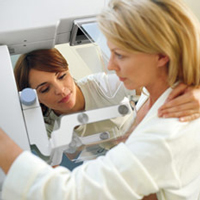Moab Regional Hospital is celebrating National Breast Cancer Awareness Month.
 Moab Regional Hospital is celebrating National Breast Cancer Awareness Month. Breast cancer is the second most common cancer in American women next to lung cancer. Although men can develop breast cancer this article is targeted towards early detection in women. Women have a one in eight chance of developing breast cancer in their lifetime. Death rates from breast cancer have been declining since about 1990. This decrease is believed to be the result of earlier detection through screening exams, increased awareness, and improved treatments. At this time there are over 2.5 million breast cancer survivors in the United States. Moab Regional Hospital is celebrating National Breast Cancer Awareness Month. Breast cancer is the second most common cancer in American women next to lung cancer. Although men can develop breast cancer this article is targeted towards early detection in women. Women have a one in eight chance of developing breast cancer in their lifetime. Death rates from breast cancer have been declining since about 1990. This decrease is believed to be the result of earlier detection through screening exams, increased awareness, and improved treatments. At this time there are over 2.5 million breast cancer survivors in the United States.
There are some factors that can put a woman at a higher risk of developing breast cancer. Having a risk factor, or even several does not mean that you will get the disease. Many women with risk factors never develop breast cancer, while many of the women diagnosed with the disease have no risk factors other than being female. Over 85% of women diagnosed with breast cancer have no family history of the disease. Some risk factors for breast cancer include; being female, over the age of 55, genetics, a personal history of breast cancer, ethnicity, and dense breast tissue. Some risk factors that are lifestyle related include; women who have had no children or their first child after the age of thirty, hormone therapy, alcohol use, and obesity.

There is no sure way to prevent breast cancer. The most important thing a woman can do to defend herself against breast cancer is follow early detection guidelines. The American Cancer Society recommends:
Women age 40 and older should have a screening mammogram every year and should continue to do so for as long as they are in good health.
Women in their 20s and 30s should have a clinical breast exam (CBE) as part of a periodic (regular) health exam by a health professional, at least every 3 years. After age 40, women should have a breast exam by a health professional every year.
Breast self exam (BSE) is an option for women starting in their 20s. Women should be told about the benefits and limitations of BSE. Women should report any breast changes to their health professional right away.
Women at high risk should talk with their health care professional to decide if earlier testing and/or further testing such as a breast MRI should become part of their routine screening exams.
 Moab Regional Hospital has improved their services in the fight against breast cancer, to include installation of a new digital mammography unit with computer aided detection. Along with experienced oncologists, plastic surgeon, and general surgeon for treating patients close to home after diagnosis. For a mammogram appointment call 719-3690. The Utah Cancer Control Program offers cancer screening exams, including mammograms at little or no cost to qualifying individuals through the state health department. For the health department in Moab call 259-5602. Moab Regional Hospital has improved their services in the fight against breast cancer, to include installation of a new digital mammography unit with computer aided detection. Along with experienced oncologists, plastic surgeon, and general surgeon for treating patients close to home after diagnosis. For a mammogram appointment call 719-3690. The Utah Cancer Control Program offers cancer screening exams, including mammograms at little or no cost to qualifying individuals through the state health department. For the health department in Moab call 259-5602.
Grand County Wellness Center
Everybody kept telling me I needed to see ‘that hormone doctor’ in Moab. I'm sure glad I did. Finally I’ve found a doctor wh o cares enough to listen to me and figure out what is going wrong instead of just prescribing an antidepressant that I don’t need." Men and women from all over Utah—as well as from New Mexico, Colorado, Montana, and even Alaska—echo this statement as they meet with staff in the Grand County Wellness Center. Although patients are initially drawn here in search of a sensible and effective approach to the hormonal imbalances that plague much of our population, young and older alike, many come to discover that there is a lot more to the Wellness Center than bio-identical hormone replacement. In fact, some learn—to their surprise—that sex hormone deficiencies are not their problem after all, or at least not their main problem. o cares enough to listen to me and figure out what is going wrong instead of just prescribing an antidepressant that I don’t need." Men and women from all over Utah—as well as from New Mexico, Colorado, Montana, and even Alaska—echo this statement as they meet with staff in the Grand County Wellness Center. Although patients are initially drawn here in search of a sensible and effective approach to the hormonal imbalances that plague much of our population, young and older alike, many come to discover that there is a lot more to the Wellness Center than bio-identical hormone replacement. In fact, some learn—to their surprise—that sex hormone deficiencies are not their problem after all, or at least not their main problem.
 Although Dr. Andrew was trained in the traditional Western medical approach to disease, and continues to use that training in the everyday practice of family medicine, it became clear to him early on in practice that something was lacking. "Every time we go to the doctor, we are conditioned to expect to receive a drug—or undergo surgery—for each symptom that ails us. It’s no wonder we are getting sicker as a people and bankrupting our health care system. I believe there is a role for drugs. I prescribe them every day. However, every drug has its side effects and long-term complications, many of which are unknown. Who would have thought a few years ago that the most common cholesterol drugs would contribute to diabetes, depression, hormone deficiencies, and heart failure? These facts are not taught in medical school and the drug companies would rather us not think about them as we dutifully fill our expensive prescriptions every month for the rest of our lives. Making matters worse, an alarming number of Americans are taking 5, 10, or even 15 prescription drugs a month, often at a cost of over $100 a piece. If the multiple side effects and drug interactions don't kill us, the gutting of our life savings will." Although Dr. Andrew was trained in the traditional Western medical approach to disease, and continues to use that training in the everyday practice of family medicine, it became clear to him early on in practice that something was lacking. "Every time we go to the doctor, we are conditioned to expect to receive a drug—or undergo surgery—for each symptom that ails us. It’s no wonder we are getting sicker as a people and bankrupting our health care system. I believe there is a role for drugs. I prescribe them every day. However, every drug has its side effects and long-term complications, many of which are unknown. Who would have thought a few years ago that the most common cholesterol drugs would contribute to diabetes, depression, hormone deficiencies, and heart failure? These facts are not taught in medical school and the drug companies would rather us not think about them as we dutifully fill our expensive prescriptions every month for the rest of our lives. Making matters worse, an alarming number of Americans are taking 5, 10, or even 15 prescription drugs a month, often at a cost of over $100 a piece. If the multiple side effects and drug interactions don't kill us, the gutting of our life savings will."
 Rather than merely "manage" (i.e. perpetuate) disease, Dr. Andrew decided to focus on helping patients enhance their health and prevent disease. As a result of this decision, he regularly attends conferences and lectures by national experts in all areas of medicine. The emphasis of this advanced training is to help patients return, as much as possible, to optimal health. Sometimes this requires the use of certain drugs, at least temporarily. In other circumstances it involves vitamins, minerals, herbs, or hormones, alone or in combination. At the same time, Dr. Andrew is quick to point out that many of the illnesses from which we suffer stem from things that we do to ourselves. Lifestyle, environment, and attitude are inseparably connected with our health. Unfortunately, no combination of drugs can overcome the effects of some of the poisons we put in and on our bodies, some knowingly and others unknowingly. Rather than merely "manage" (i.e. perpetuate) disease, Dr. Andrew decided to focus on helping patients enhance their health and prevent disease. As a result of this decision, he regularly attends conferences and lectures by national experts in all areas of medicine. The emphasis of this advanced training is to help patients return, as much as possible, to optimal health. Sometimes this requires the use of certain drugs, at least temporarily. In other circumstances it involves vitamins, minerals, herbs, or hormones, alone or in combination. At the same time, Dr. Andrew is quick to point out that many of the illnesses from which we suffer stem from things that we do to ourselves. Lifestyle, environment, and attitude are inseparably connected with our health. Unfortunately, no combination of drugs can overcome the effects of some of the poisons we put in and on our bodies, some knowingly and others unknowingly.
What gratifies Dr. Andrew most is being able to help patients return to health and wellness by removing from the body things that don't belong there and putting back things that do. "It's exciting to me when I can treat in a matter of weeks or months a myriad of symptoms for which only 10 years ago I would have written 5 or more potentially lifelong prescriptions. It's a lot of work for doctor and patient alike, but many agree it is more than worth it. We're going through a huge culture shift right now. Just as some people will never embrace computers, some would rather not take the active role in their health that is required for wellness. Fortunately, ever-increasing numbers of people are becoming more educated about their health and are no longer satisfied with statements like 'It's all in your head,' 'You're just getting older,' and ‘You just need to eat less and exercise more.’” For the first time, many patients are realizing they have options. Thanks to the recent addition of Physician Assistant Keely Fitzgerald, the Wellness Center and the Family Practice office are able to accommodate more of both types of patients than ever.
|